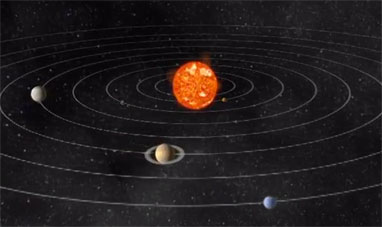Petroleum (oil) is derived from the sedimentation of organisms that accumulate in the sea bed of oceans and lakes. These organic deposits are transformed into a solid mixture of carbon-based "kerogen" and, subsequently, into hydrocarbons. Hydrocarbons are substances formed by carbon and hydrogen atoms. The duration of this transformation process varies from 10 to 100 million years, which is why petroleum oil is considered a "non-renewable" energy source. The oil accumulates and then moves within porous and permeable reservoir rocks. These reservoirs are held in place by the impermeable rocks surrounding it, thanks to their convex shape.
If the amount of oil has accumulated to such proprtions as to be economically exploitable, it becomes what is known as a field
The only way to ascertain the value of an oil field is to drill a well. To do this, hollow rods are connected to a rotatating chisel capable of drilling into solid rock to a depth of 8,000 meters. Smaller fields contain several hundred tons of petroleum while larger filelds may hold an excess of over 10 billion tons. Once extracted, the crude oil is then sorted and stored in tanks before being transported to refineries through pipelines or by tankers. Alternatively, transportation can also occur via specially equipped cars or trains: tankers or tank cars. Petroleum is used in industry as fuel for transportation and heating, such as gasoline, diesel and kerosene. It can also be used in the creation of plastics, detergents, rubbers, fibers, dyes and explosives. Oil derivatives constitute the basic products of the chemical industry. 1 kg of crude oil is equal to 10,000 kilocalories: a yield much higher than would be obtainable by other energy sources such as coal, wind and solar.
This feature, together with relatively simple transportation methods, makes oil the #1 source of energy used worldwide. Oil accounts for 38% of the global demand for electricity production. Each year 0.03 trillion barrels are extracted from the planet.
The world’s principal oil fields are concentrated in the Middle East, followed by North America, Asia, Africa, Latin America and Europe. The Middle East, however, produces far less than its potential, while the United States and Western Europe consume more oil than it possesses. Western Europe alone consumes 22% of the world’s production each year, and together with North America, is on target to deplete its reserves in a few years. In time these geographical areas will be forced to resort to using more and more imported oil causing the price of oil, due to its increasingly high demand, to skyrocket. The production and consumption of oil has a considerable impact on the environmenta. For example, during combustion the hydrocarbons in the atmosphere release large amounts of CO2. It is for this reason that most of the larger energy companies have turned their attention toward research that will ensure the reduction of emissions.
If the amount of oil has accumulated to such proprtions as to be economically exploitable, it becomes what is known as a field
The only way to ascertain the value of an oil field is to drill a well. To do this, hollow rods are connected to a rotatating chisel capable of drilling into solid rock to a depth of 8,000 meters. Smaller fields contain several hundred tons of petroleum while larger filelds may hold an excess of over 10 billion tons. Once extracted, the crude oil is then sorted and stored in tanks before being transported to refineries through pipelines or by tankers. Alternatively, transportation can also occur via specially equipped cars or trains: tankers or tank cars. Petroleum is used in industry as fuel for transportation and heating, such as gasoline, diesel and kerosene. It can also be used in the creation of plastics, detergents, rubbers, fibers, dyes and explosives. Oil derivatives constitute the basic products of the chemical industry. 1 kg of crude oil is equal to 10,000 kilocalories: a yield much higher than would be obtainable by other energy sources such as coal, wind and solar.
This feature, together with relatively simple transportation methods, makes oil the #1 source of energy used worldwide. Oil accounts for 38% of the global demand for electricity production. Each year 0.03 trillion barrels are extracted from the planet.
The world’s principal oil fields are concentrated in the Middle East, followed by North America, Asia, Africa, Latin America and Europe. The Middle East, however, produces far less than its potential, while the United States and Western Europe consume more oil than it possesses. Western Europe alone consumes 22% of the world’s production each year, and together with North America, is on target to deplete its reserves in a few years. In time these geographical areas will be forced to resort to using more and more imported oil causing the price of oil, due to its increasingly high demand, to skyrocket. The production and consumption of oil has a considerable impact on the environmenta. For example, during combustion the hydrocarbons in the atmosphere release large amounts of CO2. It is for this reason that most of the larger energy companies have turned their attention toward research that will ensure the reduction of emissions.






































